

| Monitoring the Oil Beetle in Nottinghamshire |
| The Oil Beetle in Nottinghamshire |
| ..... |
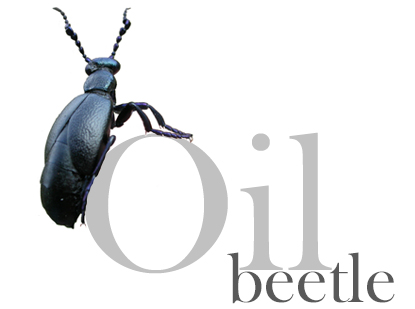 |
The rediscovery of the Oil Beetle
(Meloe proscarabaeus) in VC56 Nottinghamshire for the
first time in over a 100 years, has since provided us
with the chance to monitor the colony over successive
years. The discovery of Meloe proscarabaeus on Budby South Forest (part of the Sherwood Forest NNR) by Adrian Dutton and his wife in 2011, was followed a couple of years later by James Glendenning and Sean Tobin's independantly reported colony in the grounds of Newstead Abbey. In 2023, another colony was found in Clumber Park and doubtless, there are others out there somewhere. This page purely serves to provide summaries of our own survey results of the Budby South Forest colony, plus additional sightings sent to us for inclusion here. For further details on the life history of this extremely large beetle, click on the link above left. |
|
| ..... | ||
| 2025 survey results
and notes After what was perhaps the coolest Winter for a number of years, mild weather finally turned up from February 19th and so it was no real surprise that the first Oil Beetles of the year appeared on February 22nd. A total of 15 were recorded from the usual spoil heaps at the western end of Budby South Forest, all of which (somewhat unusually) appeared to be males. |
||
|
A few days later on February 25th, I visited Newstead Abbey from
around mid-morning, and soon located several Oil Beetles around the
stump of a tree, just up from the car park. In fact I had parked less
than ten yards away. A thorough survey of the entire car park and cricket pitch areas, produced a total of ten Oil Beetles, with none found around the cricket square or outfield. On a positive note, I did locate a male at the eastern end of the car park, in an area in which Dilys and I never recorded any during previous visits. Chris Jackson also visited Newstead, going on March 2nd and recorded a total of 11 Oil Beetles in the north-eastern corner of the cricket pitch, during a brief survey. But these survey counts from Newstead, were considerably bettered a few days later by David Shaw. He visited the Newstead Abbey on March 3rd and found only a single Oil Beetle in the car park area, but then had over 100 in the cricket pitch area, which I think is an absolutely astonishing count, by any UK standard. |
 |
|
| I visited Newstead again the next day (March 4th) not only to see such
numbers for myself, but also to film them for the 'Ramblings of an
entomologist' YouTube channel. The finished video can be found here
https://youtu.be/C_NrE_B8sgo?si=MPQe2OIRotUuj1k4 I ended up with a total of 95, most being found around the bases of trees bordering the cricket outfield, with some on the outfield itself and above the nearby car park. Newstead was then independently visited by both Chris Jackson and Lee Scudder on March 8th. Chris surveyed for longer this time and ended up with a total of 35 Oil Beetles, most around the cricket pitch area, but he did record three around the car park. Sometime that same day, Lee visited the site and counted 53, so still good numbers. For such a large species, it is surprising how they can be missed. Lee later went to survey the Bulwell Forest Golf Course site, but no Oil Beetles were found. It is still possible, that they are still present, so it's always worth visiting. |
||
|
2024 survey results
and notes After mild weather during the opening days of February, a survey for early individuals on February 2nd proved negative. Cooler weather followed with a fall of snow and lower temperatures until it became increasingly mild mid-month. After a pleasantly warm 15th, a survey conducted around the western-end of Budby South Forest on February 16th, provided a very good cound of 14 (11 ♂ and three ♀). All were found on the old spoil heaps, which year after year, have continued to provide the first records. It was noted that several larger specimens had clearly been out for a number of days and had fed, but a mating pair were a surprise to see on this early date. No other Oil Beetles were found along the nearest paths and tracks. And good news from the other Nottinghamshire site for Meloe proscarabaeus at Newstead Abbey, where David Shaw recorded 30 in the area of the cricket pitch on February 19th. Amazing counts this early in the year. |
||
| 2023 survey results
and notes Weatherwise quite an unusual start to the year with mixed conditions and varying temperatures, including a very cold spell in January and a brief covering of snow in early March. I made a visit to Budby SF on February 15th and saw a recently emerged male sunning itself on one of the spoil heaps, in the favoured area at the western-end of the reserve. This may well be the earliest recorded date and the male had certainly been feeding for a couple of days prior, judging on abdomen size. Reserve manager Chloe Ryder reported a count of nine (six ♂ and three ♀) on March 13th, which was an indicator of the milder conditions. A pair were even noted 'in cop'. 2022 survey results and notes What are believed to be the first Oil Beetles of 2022 were grazing on February 16th. Three were found (two ♂ and a ♀) all of which were small. It looked as though two had emerged that morning, but one was better fed and possibly around a week old. A second visit to Budby didn't come till March 14th when a total of 13 Oil Beetles (six ♂ and seven ♀) were found. There was evidence of a small range increase on site, with beetles found further east along the main track heading away from the usual area. |
||
| ..... | ||
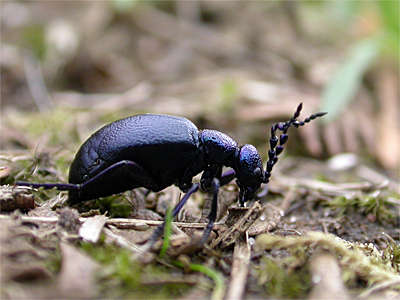 |
A total of 11
adults were found in this same general area and reported to me on March
27th by Nick and Samantha Brownley. The total included many
burrowing/egg-laying females. I'd already visited Budby South Forest twice three times (including a very mild New Year's Eve) just in case some beetles had been tempted into an early emergence. Non were recorded and neither were any found at Nottinghamshire's other site at Newstead Abbey, although my visit there was far too early. In fact, there had been no records reported from Newstead since David and Veronica McGeever reported them, as long ago as March 2016 at SK540536, so when David Shaw visited Newstead Abbey on April 11th, it was great to see that they have somehow managed to survive there, despite the heavy footfall. David found two live Oil Beetles and recorded at least one dead. Another site in need of checking this year is Bulwell Forest Golf Course, where Oil Beetles were reported to have been seen back in 1970 at SK547460 (per Skudder, L.). Indeed, this would be an interesting site to survey, especially as both M. proscarabaeus and M. violaceus historically occurred there. |
|
| ..... | ||
| 2021 survey results
and notes After two early surveys, the first Oil Beetle of the year (a male) was found freshly emerged and heading for cover on a fairly breezy, but mild February 18th. In terms of early dates, this looks to be the earliest at Budby and follows a spell of cold weather that ended a few days prior to my visit. The next report was of two females present on February 27th, when I was expecting better numbers, given the recent mild weather. I must admit to being concerned that this population is weakening. A site visit on March 7th produced a total of seven adults, which included five males and two females. Five of these were found on the spoil heaps created from recently scraped areas of the heath. Seven is still a low count, but the weather had been dry and cool with occasional frosts since my previous visit. There were no reports sent in before I visited the site to survey again on March 29th. Oil Beetles were located in two (well separated areas) with none found along the usual stretch of track. The habitat here continues to become even more unsuitable and the effect of increased footfall erosion is becoming even more obvious and worrying. Away from the track, a total of eight Oil Beetles (six ♂ two ♀) were confined to the post scrape spoil heaps, where the grass is broader leaved and provides better grazing. The only other Oil Beetles were located in a small area of recently scraped track and incuded three♀ and a single ♂. 2020 survey results and notes Following another very mild Winter overall, I made a trip to the western end of Budby South Forest on February 27th, in the hope that (despite the cool and slightly breezy conditions on the day) the first adults might already be out. The visit paid off, with a total of seven adults found along the usual stretch of path, all rather inactive and sheltering from the breeze. All those found were typically small and freshly emerged. By March 11th, numbers had significantly increased and a count of 37 (per Indy Kiemel Greene) included several pairs seen in cop, while some 17 Oil Beetles were found along track in the usual area at the western-end of Budby SF on March 16th (per Samantha Batty). The most recent count available, is of a rather disappointing 11 present on March 22nd (per Indy Kiemel Greene). |
||
| ..... |
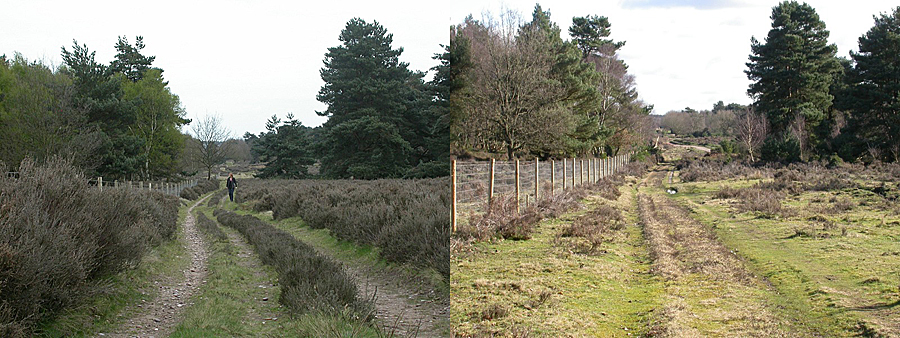 |
| ..... |
| I visited again on March 25th and
again, as in the previous report, found very disappointing numbers. Just
a single burrowing female was found and only a further two males were
noted along the favoured path, out of a total of 11. One grazing female
was located well away from the path (in an area where they were regular)
but in all honesty, the whole area and stretch of track has become much
less suitable in recent years (see above photograph with current
conditions on the right) grassing over and opened up as the amount of
Heather reduces. Oil Beetles on both my visits this year, have been
along a much shorter section of path, being found mostly where small
copses of Birch and Pine come close either side of the track. Grass of
suitable grazing quality is now extremely sparse, as the Heather has
been cleared and the ground opened up to increased sun. 2017 survey results and notes Chloe Ryder of the RSPB reported the first of the year's Oil Beetles were already active on February 23rd. This is the earliest date we know of since they were found back in 2011, beating last year's early date of February 28th, by some five days. 2016 survey results and notes Following an almost non-existant Winter, where at home we had recorded frosts on fewer than ten occasions and just an inch of snow for one day (to the end of February) we made an earlier than normal first visit to the western end of Budby South Forest. The first Oil Beetle was found almost immediately following arrival on site and a total of eight males were eventually recorded on 28/02/02. Our second visit was some three weeks later on 20/03/16 and an impressive count of 44 Oil Beetles was made. Approximately 75% were males and several females were recorded mating. However, all females and most of the males we found, were still well short of their normal weight and emergence seems to be a more prolonged process this year. Oil Beetles from the Newstead Abbey colony were recorded from mid-March at the latest by Dave & Veronica McGeever, who counted 20 adults (50% m/f) on 14/03/16. |
| ..... |
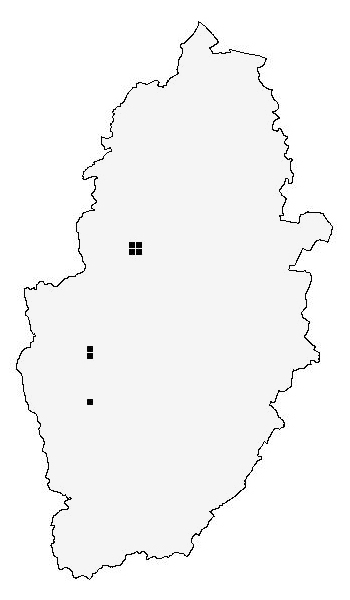 |
2015 survey
results and notes Our first site visit to Budby South Forest on 07/03/15, coincided with the first warm day of the Spring. Despite the early first date of the previous year, we were surprised to find that Oil Beetles were already out (despite a cool Spring to date) and had been so for a few days at least. All but one of the 36 counted were males, most were small and busy feeding up. Sean Tobin emailed us to say that the Oil Beetle colony at Newstead Abbey, had first been recorded on 06/03/15 this year. 2014 survey results and notes With the mild Winter continuing and a gradual warming of the daily temperatures, the first Oil Beetles were found to have already emerged at their Budby South Forest site by 03/03/14, over a month earlier than in 2013. We were actually surprised to find any, and in fact were just checking the state of the site in readiness for the beetles possibly emerging in a couple of weeks time. So we were amazed to record our first Oil Beetle within a few minutes of searching, eventually recording a total of 19 Oil Beetles, all of which proved to be males. Just under a week later (09/03/14), a further survey resulted in the first females being recorded, but only seven females out of an excellent total of 54 adults. 2013 survey results and notes Delayed by the very cold weather during March, when we did make one site visit around mid-month, the first adults were not out until 06/04/13, when 25 (17 males and eight females) were recorded during a thorough survey of the western end of the site. A single female found in a new area, was well away from the main colony and the first real sign of range expansion across the site. The following day (07/04/13) we conducted a second thorough site survey, this time recording approximately 70 adults. The count consisted of 34 males and 26 females, but we were unable to locate Oil Beetles in any additional areas of the site. Most of the beetles recorded were grazing and included several mating pairs. |
| ..... | ||
| A later site visit was
made on 20/04/13, resulting in a count of 41 adults.
Burrowing females, completed burrows containing eggs and
mating pairs were observed. On 22/04/13 we received news of a report of Meloe proscarabeus at a second Nottinghamshire site from the team at the Sherwood Forest Trust, although the find is believed to have been made by James Glendenning. Following a short survey of the site the following day, we located a total of five males and four females. Unfortunately, these were the only live beetles we found and the dead numbered over 25. At first we were not going to publish the location of the find, but we now feel that it is OK to mention that the site is located in a very public area of Newstead Abbey grounds. It therefore seems logical to believe that Oil Beetles may also be present at additional sites in Nottinghamshire. 2012 survey results and notesWe made just two site visits during 2012, recording totals of 61 adults on 23/03/12, followed by 47 adults on 05/04/12. There was evidence (through records) of a slight increase in range, but this continues to be extremely localised on site. |
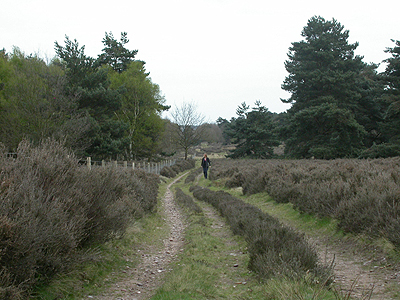 |
|
| ..... | ||
|
Heavy machinery used in managing the site, or for the movement of Longhorn Cattle, was believed by one observer to have had an extremely detrimental affect on the burrows made by females. 2011 survey results and notes In 2011 we made several attempts to locate this beetle and were eventually successful on our third visit on April 12th. We found ten beetles in one very small area of the site, followed by another female well away from this, later found to be the same location as the original record. The following afternoon, a further survey revealed that the colony covered a slightly larger area than was first realised. A count of 33 was made, consisting of slightly more females than males. Several other adults were found trodden on, but the colony seems to be reasonably well populated, with a later survey on April 20th, revealing 37 adults (21f and 16m) and also showing evidence of colony dispersal east and west, but still remaining within a very small area of the site. It was interesting to note that during the morning, both males and females were found grazing on grass, which on very warm days, was often found to be in areas of shade. Fescue grasses were largely ignored by feeding adults, the beetles preferring slightly coarser grass. By April 29th, a further survey of the area found a total of ten adults, all of which were females. Many of these were still burrowing in sandy/stony sections of the preferred path, but there was again, further evidence of continued spread eastwards. |
||